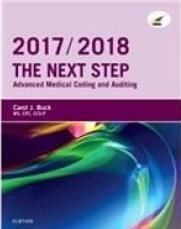
The Next Step Advanced Medical Coding and Auditing 2017- 2018 1st Edition by Carol Buck
Edition 1ISBN: 978-0323430777
The Next Step Advanced Medical Coding and Auditing 2017- 2018 1st Edition by Carol Buck
Edition 1ISBN: 978-0323430777 Exercise 2
Case 13-2
LOCATION: Outpatient, Hospital
PATIENT: Pat Zapata
ATTENDING PHYSICIAN: Jeff King, MD
SURGEON: Jeff King, MD
PREOPERATIVE DIAGNOSIS: Bilateral mixed hearing loss with significant conductive component in the lower frequencies, left ear worse than the right.
POSTOPERATIVE DIAGNOSES
1. Bilateral mixed hearing loss with significant conductive component in the lower frequencies, left ear worse than the right.
2. Left middle ear tympanosclerosis around the incus and stapes.
PROCEDURE PERFORMED
1. Left middle ear exploration.
2. Left incus and stapes mobilization.
ANESTHESIA: General endotracheal.
INDICATIONS: This is a 16-year-old female with a long history of hearing loss. Recent audiometric testing indicated bilateral mixed hearing loss with a significant conductive component in the lower frequencies. The left ear was worse than the right. The patient has used hearing aids but noted that the hearing aid is not as effective as it had been. As such, the patient's mother opted for exploration to correct any ossicular abnormality if noted, with the exception of stapedectomy.
PROCEDURE: After consent was obtained, the patient was taken to the operating room and placed on the operating table in supine position. After an adequate level of general endotracheal anesthesia was obtained, the patient was positioned for surgery on the left ear. The patient's left ear was prepped with Betadine and draped in a sterile manner. One-percent Xylocaine with 1:100,000 units of epinephrine was infiltrated into the postauricular area and then in all four quadrants of the ear canal. The speculum was secured with a speculum holder. A tympanomeatal flap was then elevated in standard fashion. The ossicular chain was intact; however, the incus and stapes were not mobile. There was tympanosclerotic plaque around the incus and stapes. With meticulous dissection this was removed. Subsequently, the incus and stapes were mobile. The round window area showed that the niche was very deep, and the membrane could not be seen. Fluid was placed into the niche to see if a round window reflex could be elicited, but a clear obvious round window reflex was not elicited. The tympanomeatal flap was then placed back in its normal position. Gelfoam soaked with Physiosol was then placed lateral to this and brought out through the proximal ear canal. The proximal ear canal was then filled with Bacitracin ointment. A cotton ball coated with Bacitracin ointment was placed in the conchal bowl area and a Band-Aid dressing applied.
The patient tolerated the procedure well, there was no break in technique, and the patient was extubated and taken to the postanesthesia care unit in good condition. Fluids administered: 1000 cc RL. Estimated blood loss: Less than 5 cc.
CPT Code(s): _________________
ICD-10-CM Code(s): _________________
Abstracting Questions:
1. Is the mobilization of the incus reported separately? _________________
2. What procedure was the surgeon NOT authorized to perform? _________________
LOCATION: Outpatient, Hospital
PATIENT: Pat Zapata
ATTENDING PHYSICIAN: Jeff King, MD
SURGEON: Jeff King, MD
PREOPERATIVE DIAGNOSIS: Bilateral mixed hearing loss with significant conductive component in the lower frequencies, left ear worse than the right.
POSTOPERATIVE DIAGNOSES
1. Bilateral mixed hearing loss with significant conductive component in the lower frequencies, left ear worse than the right.
2. Left middle ear tympanosclerosis around the incus and stapes.
PROCEDURE PERFORMED
1. Left middle ear exploration.
2. Left incus and stapes mobilization.
ANESTHESIA: General endotracheal.
INDICATIONS: This is a 16-year-old female with a long history of hearing loss. Recent audiometric testing indicated bilateral mixed hearing loss with a significant conductive component in the lower frequencies. The left ear was worse than the right. The patient has used hearing aids but noted that the hearing aid is not as effective as it had been. As such, the patient's mother opted for exploration to correct any ossicular abnormality if noted, with the exception of stapedectomy.
PROCEDURE: After consent was obtained, the patient was taken to the operating room and placed on the operating table in supine position. After an adequate level of general endotracheal anesthesia was obtained, the patient was positioned for surgery on the left ear. The patient's left ear was prepped with Betadine and draped in a sterile manner. One-percent Xylocaine with 1:100,000 units of epinephrine was infiltrated into the postauricular area and then in all four quadrants of the ear canal. The speculum was secured with a speculum holder. A tympanomeatal flap was then elevated in standard fashion. The ossicular chain was intact; however, the incus and stapes were not mobile. There was tympanosclerotic plaque around the incus and stapes. With meticulous dissection this was removed. Subsequently, the incus and stapes were mobile. The round window area showed that the niche was very deep, and the membrane could not be seen. Fluid was placed into the niche to see if a round window reflex could be elicited, but a clear obvious round window reflex was not elicited. The tympanomeatal flap was then placed back in its normal position. Gelfoam soaked with Physiosol was then placed lateral to this and brought out through the proximal ear canal. The proximal ear canal was then filled with Bacitracin ointment. A cotton ball coated with Bacitracin ointment was placed in the conchal bowl area and a Band-Aid dressing applied.
The patient tolerated the procedure well, there was no break in technique, and the patient was extubated and taken to the postanesthesia care unit in good condition. Fluids administered: 1000 cc RL. Estimated blood loss: Less than 5 cc.
CPT Code(s): _________________
ICD-10-CM Code(s): _________________
Abstracting Questions:
1. Is the mobilization of the incus reported separately? _________________
2. What procedure was the surgeon NOT authorized to perform? _________________
Explanation
The Next Step Advanced Medical Coding and Auditing 2017- 2018 1st Edition by Carol Buck
Why don’t you like this exercise?
Other Minimum 8 character and maximum 255 character
Character 255


